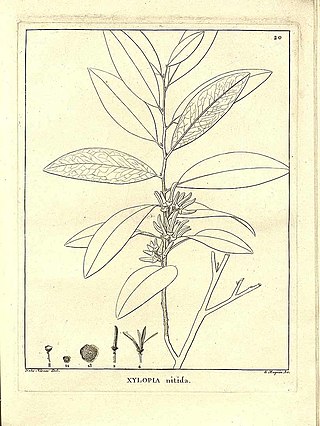Top Qs
Timeline
Chat
Perspective
Xylopia nitida
Species of flowering plant From Wikipedia, the free encyclopedia
Remove ads
Xylopia nitida is a species of plant in the Annonaceae family. It is native to Brazil, Colombia, Ecuador French Guiana, Guyana, Suriname and Venezuela.[2] Michel Félix Dunal, the botanist who first formally described the species, named it after the shiny (nitidus in Latin) upper surface of its leaves.[3][4]
Remove ads
Description
Summarize
Perspective
It is a tree reaching 20 meters in height. The young branches are covered in dense pale brown hairs, but as they mature they become hairless. Its narrow, elliptical, papery leaves are 8.5-13 by 3-4.5 centimeters. The leaves have pointed bases and tapering tips, with the tapering portion 5-10 millimeters long. The leaves are shiny and hairless on their upper surfaces, and have dense, silvery-white to brown hairs that lay flat on their lower surfaces. Its petioles are 2-6 millimeters long. Its Inflorescences occur in the axils of leaves or fallen leaves. Each inflorescence has up to 8 flowers. Each flower is on a pedicel that is 1-13 by 1-3 millimeters. Its flowers have 3 oval to triangular sepals that are 1-2 millimeters long. The lower part of the sepals are fused at their margins to form a cup-shaped calyx that is 4-5 millimeters long. Its 6 petals are arranged in two rows of 3. The orange outer petals are 18-20 by 3-5 millimeter. The orange inner petals are 15 by 1-2 millimeters. Its flowers have 170-270 stamen that are 1-1.5 millimeters long. The stamen are attached to a receptacle that forms a cone that is 1.8-2.2 by 1.2-1.5 millimeters. Its flowers have 20-30 carpels. Its stigma are capped with soft hairs. The hairless, green to red, narrow, cylindrical fruit occur in clusters of 10-27. The fruit are 10-60 millimeters long with longitudinal grooves. Each fruit has 4-6 egg-shaped seeds that are 5-6.5 millimeters long.[5][6]
Reproductive biology
The pollen of Xylopia nitida is shed as permanent tetrads.[7]
Distribution and habitat
It has been observed growing in subtropical forests, tropical moist lowlands, and savanna.[1][6]
Remove ads
Uses
Its leaf oils contain terpinenes, cymene, and limonene.[8]
References
Wikiwand - on
Seamless Wikipedia browsing. On steroids.
Remove ads


